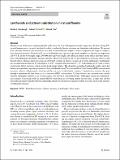Lanthanide and yttrium substitution in natural fluorite
Abstract
Fluorite is one of the most common minerals in the crust and is of widespread economic importance. It shows strong UV-excited luminescence, variously attributed to defects within the fluorite structure and lanthanide substitutions. We present here a detailed chemical characterisation of a suite of natural fluorite samples, chosen to represent the range of compositions observed in nature. We perform X-ray excited luminescence spectroscopy on the samples as a function of temperature (20–673 K) in the wavelength range 250–800 nm to provide insights into physical defects in the lattice and their interactions with lanthanide substituents in natural fluorite. Most broad bands in the UV are attributed to electronic defects in the fluorite lattice, whereas sharp emissions are attributed to intra-ion energy cascades in trivalent lanthanides. Lanthanides are accommodated in fluorite by substitution for Ca2+ coupled with interstitial F−, O2− (substituting for F−) and a variety of electronic defect structures which provide local charge balance. The chondrite-normalised lanthanide profiles show that fluorite accommodates a greater proportion of heavy lanthanides (and Y) as the total Rare Earth Element (REE) concentration increases; whereas cell parameters decrease and then increase as substitution continues. Luminescence intensity also goes through a maximum and then decreases as a function of REE concentration. All three datasets are consistent with a model whereby lanthanides initially act as isolated centres, but, beyond a critical threshold (~ 1000 ppm), cluster into lanthanide-rich domains. Clustering results in shorter REE-O bond distances (favouring smaller heavier ions), a larger unit cell but more efficient energy transfer between lanthanides, thereby promoting non-radiative energy loss and a drop in the intensity of lanthanide emission.
Citation
Horsburgh , N J , Finch , A A & Friis , H 2023 , ' Lanthanide and yttrium substitution in natural fluorite ' , Physics and Chemistry of Minerals , vol. 50 , 15 . https://doi.org/10.1007/s00269-023-01239-4
Publication
Physics and Chemistry of Minerals
Status
Peer reviewed
ISSN
0342-1791Type
Journal article
Description
Funding: Samples NJH-16-39 and NJH-16-41 were collected during fieldwork associated with the HiTech AlkCarb project, which was supported by the European Union’s Horizon 2020 research and innovation programme under grant agreement No. 689909. NJH gratefully acknowledges PhD funding from the NERC SoS RARE consortium NE/M010856/1 and the University of St Andrews. The luminescence spectroscopy facility used in the present study was funded by NERC grant NE/H002715/1. EPMA data were collected at the University of Edinburgh, UK, with the assistance of Dr Chris Hayward. For the purpose of open access, the authors have applied a CC BY public copyright licence to any Accepted Author Manuscript version arising.Collections
Items in the St Andrews Research Repository are protected by copyright, with all rights reserved, unless otherwise indicated.

